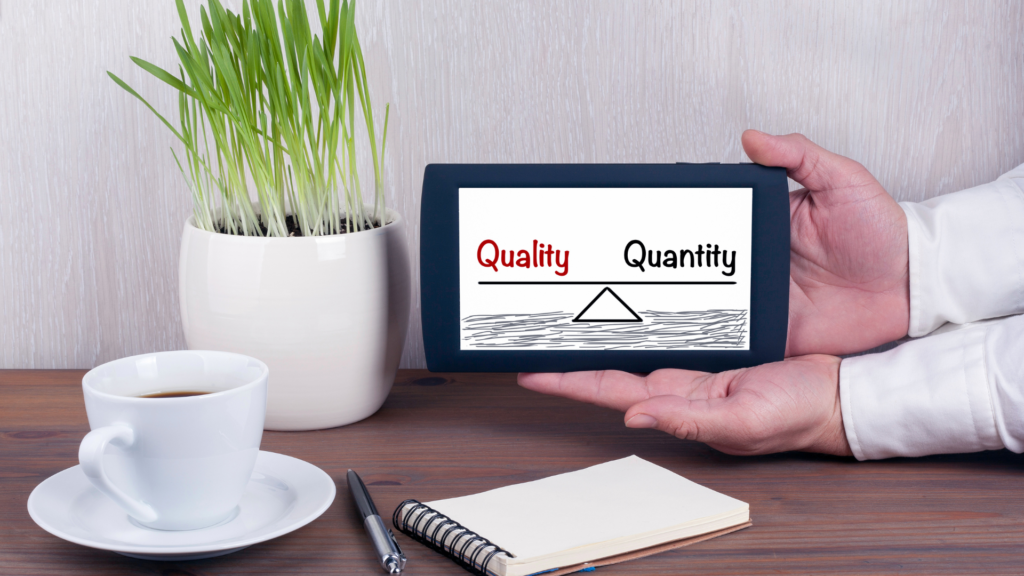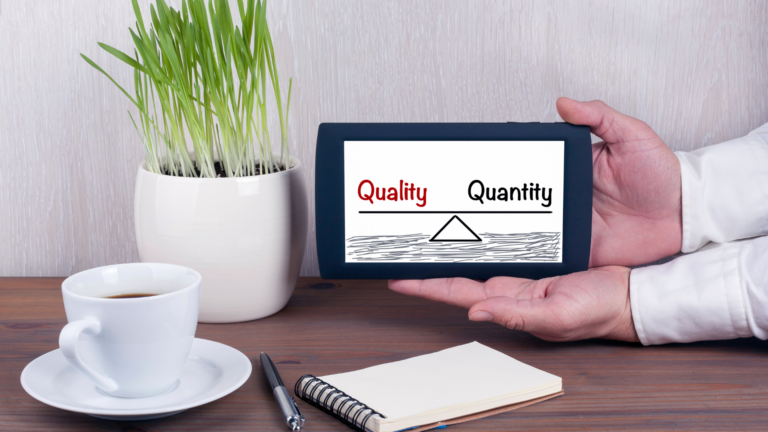- By Write RN
In the fast-paced world of healthcare marketing, content is king. But producing a high volume of content without sacrificing quality can be challenging. Striking the right balance between content quality and quantity is essential for building trust, engaging your audience, and achieving your marketing goals.
Why Balance Matters in Healthcare Content Strategy
Healthcare consumers are inundated with information. From search engines and social media to hospital websites and health blogs, patients and providers alike are bombarded with content. To stand out in this crowded landscape, your healthcare content strategy must prioritize both consistency and substance.
High-quality content builds credibility and trust. It demonstrates expertise, provides value, and answers the questions your audience is already asking. On the other hand, consistent content publishing ensures your brand remains visible, relevant, and competitive in search engine rankings. When you achieve both, you create a reliable source of information that encourages long-term engagement and loyalty.
Strategies to Balance Quality and Quantity
1. Define Clear Goals and Audience
Start by identifying your target audience and what you want to achieve with your content. Understanding your audience’s needs, pain points, and preferences will guide your content creation process. For instance, if you’re targeting patients seeking information on chronic conditions, your content should be informative, empathetic, and easy to understand. Alternatively, if your audience includes healthcare professionals, your tone may shift toward technical depth and clinical accuracy.
Clearly defined goals—whether brand awareness, lead generation, or patient education—will also help you prioritize content types and topics that deliver the highest impact.
2. Develop a Content Calendar
A content calendar is your roadmap for content creation and publishing. It helps you plan and schedule content in advance, ensuring a steady flow of publications without compromising quality. By laying out your topics, deadlines, and responsible team members, you can stay organized and minimize the chaos that leads to rushed, low-quality work.
Calendars also allow you to align content with seasonal events, awareness months, or health-related news, boosting relevancy and audience interest.
3. Prioritize High-Impact Content
Not all content carries equal weight. Focus on creating cornerstone content—comprehensive, evergreen pieces that address key topics relevant to your audience. Examples include in-depth how-to guides, research-backed explainer articles, and expert interviews.
Once developed, these high-impact assets can be repurposed into smaller, more frequent pieces such as:
- Blog summaries
- Email newsletters
- Infographics
- Short videos or social media snippets
This approach allows you to maximize your return on effort while maintaining both content quality and publishing frequency.
4. Leverage a Diverse Content Mix
People consume information in different ways. Diversifying your content formats helps you meet varied preferences while avoiding burnout from producing only one type of content. Consider incorporating:
- Blog Posts: Regularly updated articles that address current topics or common healthcare questions.
- Infographics: Visual representations of data or processes that are quick to consume and highly shareable.
- Videos: Short clips explaining procedures, introducing staff, or sharing patient testimonials.
- Podcasts: Audio content featuring health discussions, expert interviews, or real patient stories.
- Interactive Tools: Quizzes, symptom checkers, or calculators that provide value and keep users engaged.
By maintaining variety, you can keep your audience engaged and your internal team inspired.
5. Implement Quality Control Measures
Maintaining content quality across multiple formats and contributors requires a structured review process. Establish editorial guidelines to ensure consistency in tone, formatting, and voice. Create checklists for fact-checking, proofreading, and verifying regulatory compliance.
In the healthcare space, compliance is especially important. Ensure your content adheres to HIPAA, FDA regulations (when applicable), and organizational policies. A strong internal review process helps protect your brand and enhances your credibility.
Also consider using peer reviews or external reviewers for particularly sensitive or technical topics.
6. Monitor Performance and Adjust Accordingly
Your content strategy shouldn’t be static. Use analytics tools to track how your content performs over time. Monitor metrics such as:
- Page views
- Bounce rate
- Time on page
- Social shares
- Conversion rates
These insights help you understand what’s working and what needs improvement. If blog posts are driving more engagement than videos, for example, you might consider shifting some resources toward long-form written content.
Additionally, audience feedback—via comments, surveys, or email replies—can offer qualitative insights to shape future content.
7. Collaborate with Subject Matter Experts
To maintain both accuracy and authority, collaborate with healthcare professionals during content development. Interviews with clinicians, guest posts from medical staff, or review rounds by certified experts can elevate the trustworthiness of your material.
This collaboration also boosts internal buy-in from your organization, encouraging more staff to contribute or promote the content.
8. Repurpose and Refresh Existing Content
One of the most effective ways to scale your output without sacrificing quality is to reuse what you already have. Identify well-performing content that can be updated with new data or restructured for different formats.
For example, an old blog post about flu prevention can be refreshed annually or turned into an Instagram carousel, an email alert, or a downloadable checklist. Repurposing extends the life and reach of your content while reducing the pressure to constantly produce from scratch.
If you’re looking for more guidance on strategy, check out our post on how to build a healthcare content strategy that works or explore our breakdown of healthcare content marketing steps to success.
Conclusion
Balancing content quality and quantity in healthcare writing is crucial for effective communication and engagement. With a solid healthcare content strategy, you can deliver valuable, accurate, and timely information to your audience without overwhelming your team.
By setting clear goals, planning strategically, diversifying content types, and maintaining rigorous quality control, you can produce content that not only resonates with your audience but also drives measurable results.
Ready to enhance your healthcare content strategy? Explore our Healthcare Content Writing Services to learn how we can help you create high-quality, consistent content that drives results.
Frequently Asked Questions
Q1: How often should we publish new healthcare content?
Consistency is key. Aim for a schedule that you can maintain without compromising quality. This could be weekly, bi-weekly, or monthly, depending on your resources and goals. Consider your internal capacity and the content formats you plan to use.
Q2: What types of content are most effective in healthcare marketing?
Educational blog posts, patient testimonials, infographics, and videos are highly effective. They provide value, build trust, and engage different audience segments. Interactive tools and expert Q&As are also popular formats.
Q3: How can we ensure our content complies with healthcare regulations?
Implement a thorough review process that includes fact-checking, legal review, and adherence to HIPAA and other relevant regulations. Training your content team on compliance standards is also essential. Consider using compliance checklists and getting reviews from legal or regulatory experts before publishing.
References
Hotjar. (2025). Top 13+ web analytics tools to improve your site and grow your business. https://www.hotjar.com/web-analytics/tools/
The New York Times Licensing (n.d.). Repurposing Content: A 101 Guide. https://nytlicensing.com/latest/methods/repurposing-content-guide/
Ratner, H. (2023). Building a balanced healthcare content strategy. Matter Communications. https://www.matternow.com/blog/balanced-healthcare-content-strategy/

About the Author
Janine Kelbach, RNC-OB
Janine is a Registered Nurse since 2006, specializing in labor and delivery. She still works at the bedside, as needed. She built Write RN back in 2015 when she started as a freelance writer.
Over the years, and many clients later, she studied marketing, grew her marketing skills, her portfolio (over 200+ pieces), and her business to the agency it is today.




